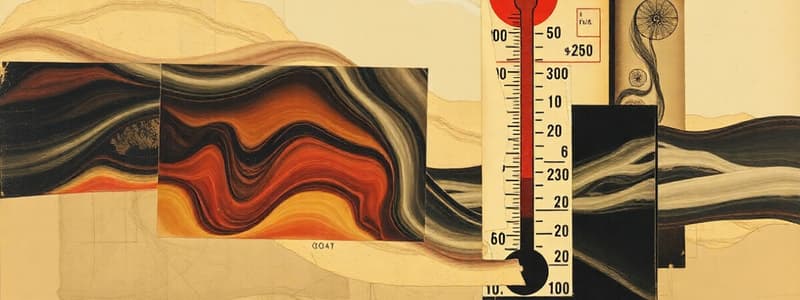Podcast
Questions and Answers
What effect does the shape of a container have on fluid pressure at a given depth?
What effect does the shape of a container have on fluid pressure at a given depth?
- It decreases pressure at lesser depths.
- It has no effect on pressure at a given depth. (correct)
- It increases pressure at greater depths.
- It affects pressure only in non-uniform containers.
Which formula correctly relates pressure, density, gravitational acceleration, and height in a fluid?
Which formula correctly relates pressure, density, gravitational acceleration, and height in a fluid?
- $P = ho h g$
- $P = ho g h$ (correct)
- $P = rac{m}{V}$
- $P = rac{F}{A}$
At what condition will the pressure at two different points in a fluid be equal?
At what condition will the pressure at two different points in a fluid be equal?
- When both points are in the same type of fluid.
- When they are both at the same temperature.
- When they are at the same height or depth. (correct)
- When the fluid has the same density.
What does density in a fluid signify?
What does density in a fluid signify?
Which of the following statements is true regarding fluid pressure?
Which of the following statements is true regarding fluid pressure?
Flashcards
Fluid Pressure
Fluid Pressure
The force exerted by a fluid on a surface, per unit area.
Density (ρ)
Density (ρ)
The amount of mass contained in a given volume of a fluid.
Pressure at Same Depth
Pressure at Same Depth
The pressure at any two points at the same depth within a fluid is equal.
Pressure Formula
Pressure Formula
Signup and view all the flashcards
Heat Transfer (Q)
Heat Transfer (Q)
Signup and view all the flashcards
Study Notes
Fluid Pressure
- Pressure (P) is a scalar quantity and is compressive, acting in all directions.
- Pressure in a fluid is directly proportional to the fluid's depth (h) and gravitational acceleration (g).
- Pressure within a fluid is equal at any two points with equal depth, regardless of the container's shape.
- Pressure formula: P = pgh, where p is the fluid's density.
Heat and Temperature
- Heat is a form of energy.
- A unit of heat is joules (J).
- Heat gained is positive (+Q), and heat lost is negative (-Q).
- Temperature is a measure of atomic variation.
Studying That Suits You
Use AI to generate personalized quizzes and flashcards to suit your learning preferences.




